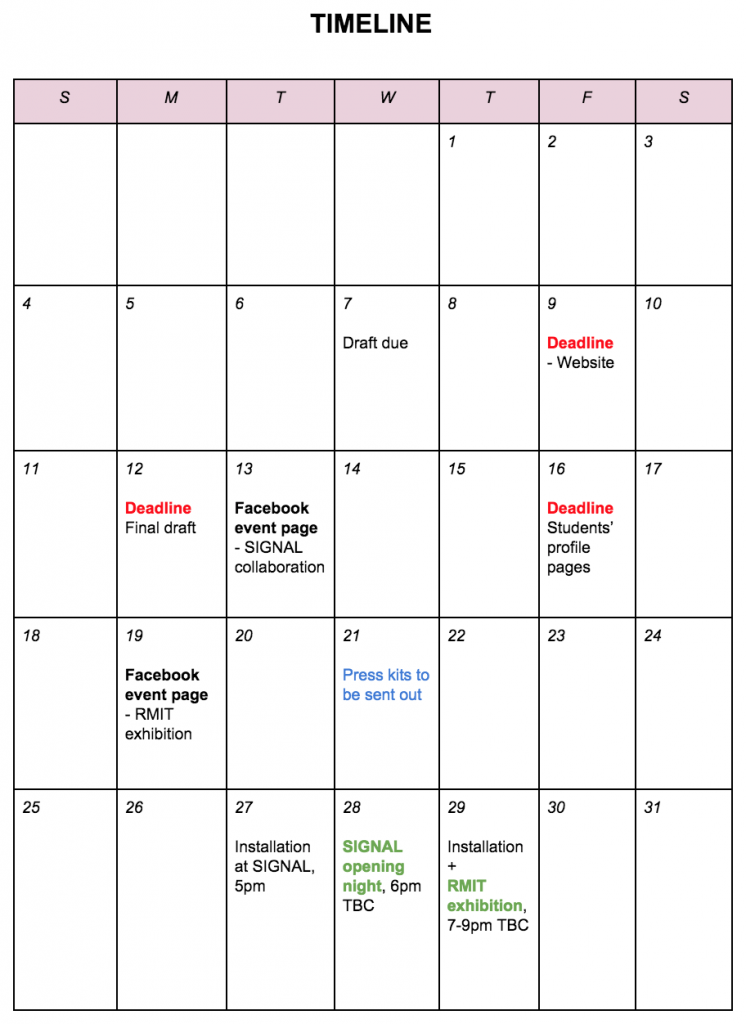Archive of ‘SIGNAL’ category
Before coming to Melbourne for my Degree, I did my Diploma in a Malaysian college that placed a lot of emphasis on practice-based learning. This meant a lot of hands-on work when it came to our assignments, plenty of planning for events, and a whole lot of being placed in real-world circumstances. Over my two and a half years in college, I grew to be very attached to any roles that involved PR or design, and that is precisely why I chose to be in the PR team for our SIGNAL exhibition.
I did my best to take the initiative to ensure that we had a clear list of things that had to be done, so that everyone knew what had to be accomplished. By working on checklists and also formatting a calendar of various events and deadlines, I did this in hopes that as a team, we would be able to help each other out when it came to completing the tasks that we were assigned to. I also worked towards getting conversations going within our Facebook group chat, monitoring and checking up on my teammates every now and then. One thing I’ve learnt is that communication within the group is extremely important, as that is how you keep each other accountable, making certain that everybody is in the loop and knows what is going on.
Being in college taught me how to make physical press kits that were attractive in design and precise in information. Rose did a great job with the poster and flyer designs, and the website was set up very nicely by my group mates. I worked on writing the press release and compiling the press kit, as most of them were unsure of how it was done. I’m glad that I had the opportunity to bring this knowledge to uni, and I worked with my PR team to create a press kit that we could look back and be proud of. I enjoyed how cohesive the group was and the individual efforts that they put into making it work. It got a little stressful at some points, especially when not everyone had settled their thumbnails and blurbs – this meant a delay in the biographies for our website, and that also caused a minor hold up in the completion and delivery of the press kit. However, it was all the more comforting knowing that we were in this as a team.
Once the posters and flyers were confirmed, I got them printed with Robbie and found a day to put them up around uni. Getting some help from my PR team, a few of us got moving and had all 40+ posters up in less than an hour. Many hands make light work, and the evident teamwork was tremendously encouraging. I also divided and distributed the flyers among ourselves so that we could go back and cut them up in our own free time. The booklets, on the other hand, were printed a day before the exhibition. However, due to some technical difficulties with the printer, the double-sided pages were not aligned and the entire stack could not be saved.
It was then that Nicolette asked if anybody could come in earlier, before our exhibition’s opening night, to reprint and settle the new booklets. In that crucial moment, it was heartening to see some of my classmates offering to lend a hand. I, too, decided to help out with the booklets, because I know exactly what it’s like to have to mend a mistake. I remember once having over 500 flyers printed with a minor mistake, and the work was only made lighter – and possible – with help from fellow teammates. The students in this Media studio have taught me that is so essential to have a sort of urgency and care towards the projects that you work on, for things will only be made difficult without cooperation.
In terms of our RMIT exhibition, I must be honest and say that I did not do much except contribute all my previous semester work, as well as a short edited video of our dinner party at Testing Grounds some weeks ago. What I’ve learnt throughout this ‘Specific to Site’ studio is not solely dependent on what I’ve achieved as a student studying Media, but the experience I’ve gained from my fellow classmates. Truly, they are inspirations – not only through what I’ve iterated regarding their excellent teamwork, but through the work that each of them have produced. Artistic in scale and rich in ideas, I can say that the past semester has ignited within me the drive to give my very best. Also, of course, none of this would be true if we didn’t have an excellent studio coordinator, Robbie. He pushed us out of our comfort zones, what with having to interact with the artists from Testing Grounds (all of which we previously have never said a word to); encouraging us to take matters into our own hands by taking up various roles for our exhibition(s); all while guiding us through and assisting us in producing exceptional content for all our projects.
As I reflect on the past semester and consider the various things that we have accomplished and attained as a class, I can say that I’ve learnt a lot as a student and practitioner, and I’m thankful that I scored my first choice when I balloted for this studio. I look forward to the adventures ahead, and am positive that this was a uni experience I am unlikely to forget.
“Society does not consist of individuals, but expresses the sum of interrelations, the relations within which these individuals stand.” — Karl Marx
Working on this final project, one thing that I was led to think about was the topic of Marxism, specifically the idea of dialectical materialism. This reflective essay will focus not on Karl Marx’s principal belief on the development of society, but more on several ideas and thought processes from Alexander Spirkin’s Dialectical Materialism, a published piece transcribed by Marxist, Robert Cymbala. There are many fundamental concepts emphasised in his writing that reflect on the growth and maturing of society, focusing on their associations with particular objects and various social relationships. I found that his thoughts and propositions, though are beliefs reworked into no more than words on a page guiding conceptual and theoretical ways of life, were also sentient and relatable in nature.
As I began to construct ideas for this project, I looked at the topic of ‘obsession’ as deeply studying a particular thing or entity – in this case, lines – and breaking it down into little pieces; an idea where those experiencing it would be prescribed to think of it through dialectics, intensifying yet directing the production of meaning. Utilising footages that encircled four central themes, I wanted to create interlinked ideas and connections between two individual elements that had a sort of parallel tie-in. The four main themes I had were: relationship, future, humanity, and passion. With each theme, I had two separate videos playing on each side of SIGNAL’s building. Both videos were different in nature, but similar and connected in idea; mutual in understanding. Spirkin (1983) believes that harmony exists in the world for the reason that materiality is present, signifying that it is the ‘carrier of multiform properties and relations’. Having that said, one can almost associate objects and elements of the world around us with one’s daily interactions and life in general – this is what I mean when I talk about the two individual aspects that I wanted to make respective to my themes.
Drawing on the concept of universal connection, it is stated that ‘every object is a link in an endless chain … [uniting] all objects and processes in a single whole and thus has a universal character’ (Spirkin 1983). The overall existence and narrative of the universe in which we reside is said to be dependent on an ‘infinite web of connections’. My audiovisual project was inspired by that idea of connecting one thing to another – I generated a story that told about the purpose and interrelations between Man and World, through my obsession with lines. In fact, considering the SIGNAL site as inspiration, I chose elements for my videos that had some form of association with the building’s physical surroundings – such as trees, train lines, people, and art.
Now, going deeper into dialectical materialism, Spirkin (1983) also talks about the principle of universal connection and development. ’Investigation of the various forms of connections is the primary task of cognition.’ Here, he emphasises the importance of careful reasoning and exploration, and how it guides our thought processes and ideas regarding universal connections. For instance, when I associated lines with the theme of humanity, I chose to think about it from two perspectives: the first being the ‘human barcode’, referring to the controversy revolving around the idea of having electronic chips assigned to every person upon birth; and the latter as a signifier of humanity, whereby the laughter lines from a person’s face were obliterated as a result of the occurring disorder. With two narratives simultaneously transpiring, it stirs the mental process by which one can acquire a deeper understanding of the given theme.
The playful behaviour between sound and visuals is another thing to explore in itself. ’Interaction is a process by which various objects influence each other, their mutual conditioning or transmutation and also their generation of one another’ (Spirkin 1983). As I watched my eight-second footages concurrently with the spontaneous sounds that emerged from SIGNAL’s sound system, it is likely to generate different understandings as art itself is subjective. After all, as Spirkin (1983) remarks, ‘interaction is causal’ and leads to what he believes is ‘development’, which is the notion that every form of connection or interaction will take a particular direction. As I ended each eight-second clip with a single word that iterated the theme, in a sense, I challenged that direction, orchestrating a specific course. There were many factors that could have influenced the audience’s perceptions, be it the visuals and/or the sounds; whether or not the text was successful in its efforts, is a question whose answers will remain a mystery.
By concocting pairs of videos for every theme, I fabricated a narrative that held universal connections with and within one another. My audio, in itself, was also a piece that contained bits of meaning and information that revolved around the brevity of human life, almost an epilogue to the four main themes. All in all, this project was an interesting exploration, and I am glad to have had the thrill of producing audiovisual works that were rich in both expression and obsession.
REFERENCES
Spirkin, A 1983, ‘The System of Categories in Philosophical Thought’, in Dialectical Materialism, Progress Publishers, Moscow, viewed 30 October 2015, <https://www.marxists.org/reference/archive/spirkin/works/dialectical-materialism/>.

Today, I paid SIGNAL another visit, but this time, I went with a friend of mine, Melissa. We headed there at about 8pm, and sat facing the corner of the building, watching the entire thing. As I watched and listened to my Media studio’s work, one thing I really enjoyed was the fact that the audio didn’t match the videos that were playing.
There was a sort of spontaneity in that, and it was really enjoyable to see and feel. Also, Melbourne has been blessed with beautiful sunsets over the past few days, so that just adds to the experience. I’m really glad that we had the opportunity to work on this as a team.
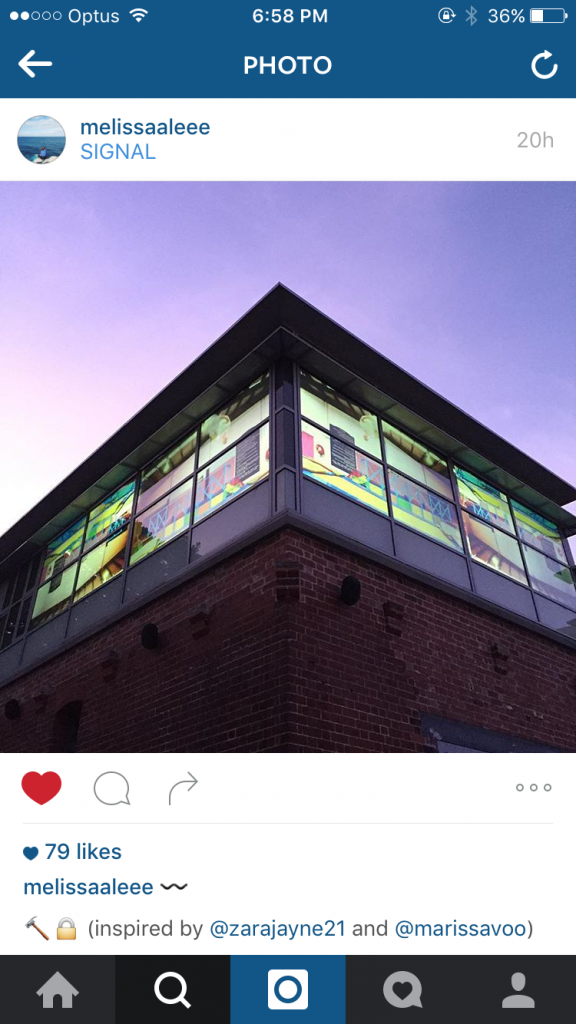
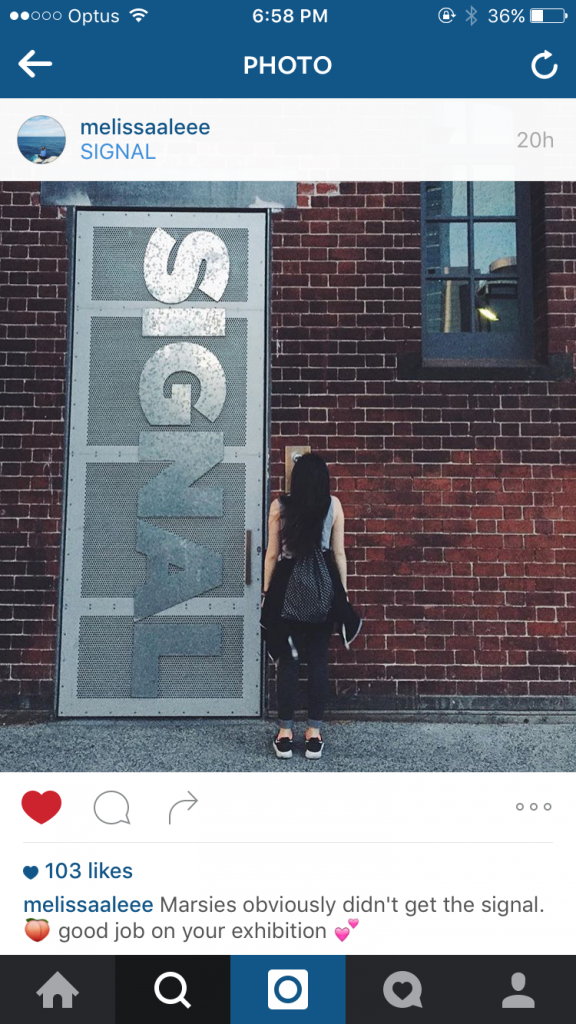
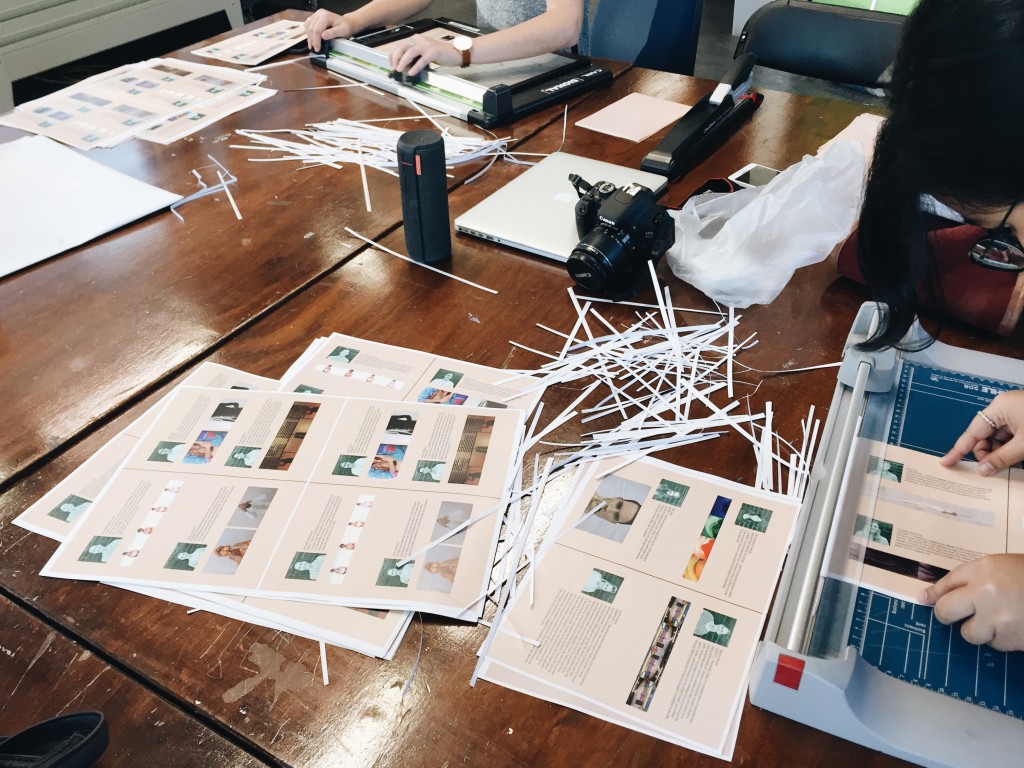
The booklets were initially printed yesterday. However, the printer was a little faulty when it came to front-and-back prints, so the booklet wasn’t aligned. It was practically impossible to save, so the class came up with a different plan, to have it one-sided instead of double-sided.
I offered to help out with the new booklets today, so some of us came earlier to get them settled. There was a total of 40 booklets, and I’m glad that we managed to get everything done right before the exhibition!
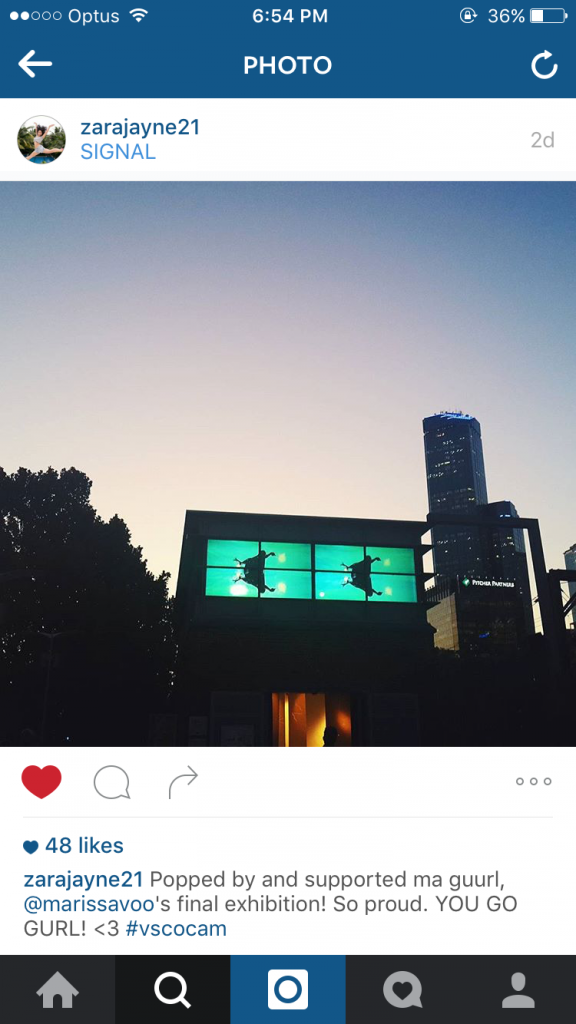
That evening, our opening night was greeted with a beautiful sunset and wonderful people. Most of my classmates brought their friends along, and I had four friends with me as well. Together, we experienced the opening night, beginning with a short speech by Claudia and Elle. The videos and sounds then came on, and everyone there watched and listened to what we had spent the past few weeks working on. It was nice.
Our whole class headed to SIGNAL today, as tomorrow would be our opening night and we wanted to see if everyone’s films were alright when displayed on the screens. I like how it turned out, and it was nice to see everybody’s work finally being exhibited at SIGNAL. Pretty excited for tomorrow!
Having planned some events back when I was in college, I found that I quite liked being in the PR team, which is precisely why I decided to involve myself in it once more. Not many of my teammates knew what a press kit was, but I’m glad that we were determined to work towards an effective one.
 I used to make physical press kits back in college, but those took up quite a bit of time and energy, in terms of creating media lists and finding people to physically send them out. That was why, this week, I spent some time doing research on how we might create a good electronic press kit. I started off by coming up with a draft press release, sent it over to Robbie to have a look, and he recommended that I use some of the content from the website.
I used to make physical press kits back in college, but those took up quite a bit of time and energy, in terms of creating media lists and finding people to physically send them out. That was why, this week, I spent some time doing research on how we might create a good electronic press kit. I started off by coming up with a draft press release, sent it over to Robbie to have a look, and he recommended that I use some of the content from the website.
It was helpful, as that made things more cohesive. After making some final edits and also attaching a cover photo for the press release, I sent it over to Robbie once more and he had it formatted.

I then worked on formatting the press kit such that it was a digital one, an e-mail version that we would be able to send out to the media. The end product also included attachments of the poster and flyer, as well as two .jpg thumbnails from Dea’s and Dusty’s film clips.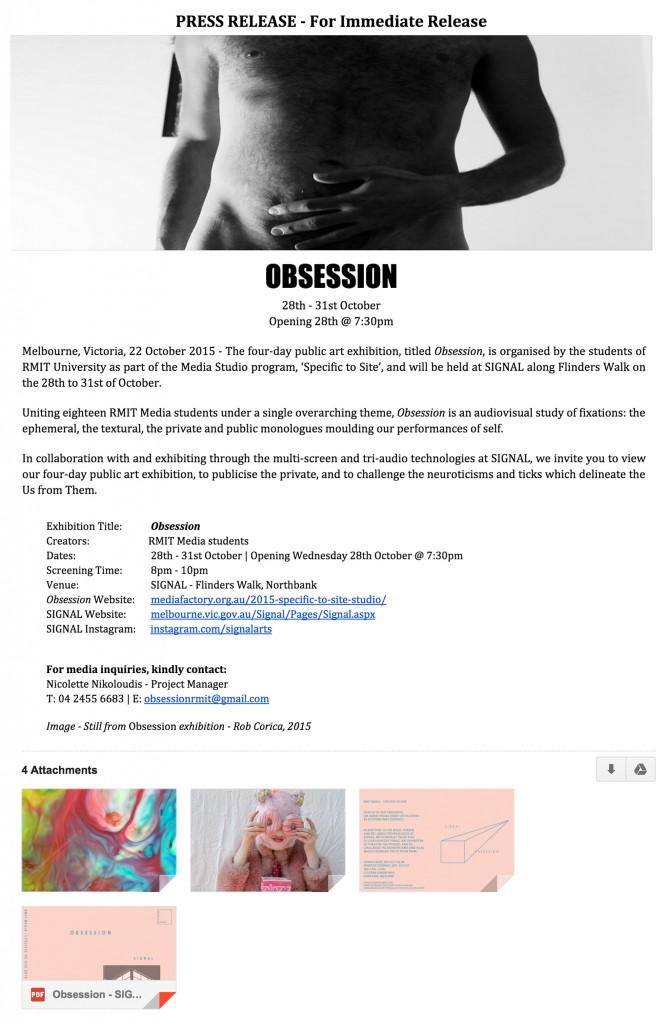 The press release was then sent to Robbie, Claudia (who was heading to Triple R), Brian (to send it across the media server), and Amanda (of SIGNAL).
The press release was then sent to Robbie, Claudia (who was heading to Triple R), Brian (to send it across the media server), and Amanda (of SIGNAL).


Elaine, Gianna, and I met up at uni today to put all the posters up. We couldn’t put any up at Building 80 as we were stopped when we tried to do so, so we focused on Building 8 and Building 9. We covered as many areas as we could, and I left them with a couple of flyers to bring home and cut.
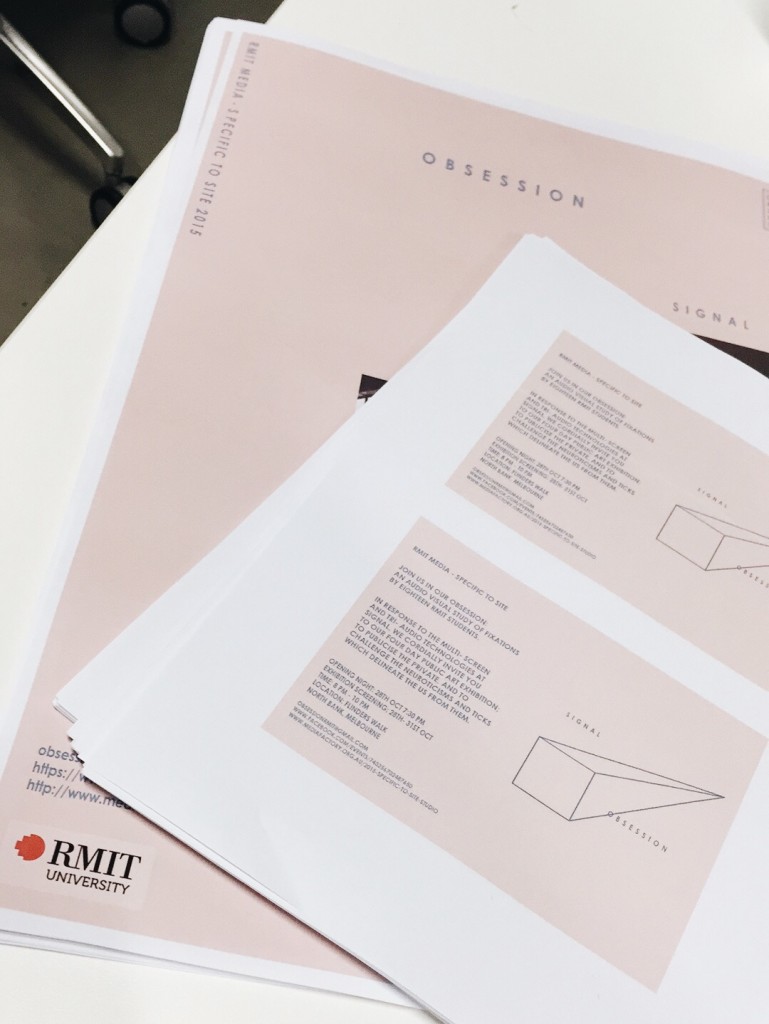
Over the past week or so, Rose has been working on the posters and flyers for our event, Obsession, and it was great to see how nice it was turning out. Today, we got to finally print them! I followed Robbie to get the printing done, and we had a bunch of A3 posters, as well as a whole lot of flyers. It all looks good, and I can’t wait to have them up on the walls of RMIT.
To kickstart what we had to get done, I created a Google Doc for the PR team, where we would be able to list down things that had to be completed. I also formatted a calendar with important dates and deadlines. This was to help us keep track of our roles.
